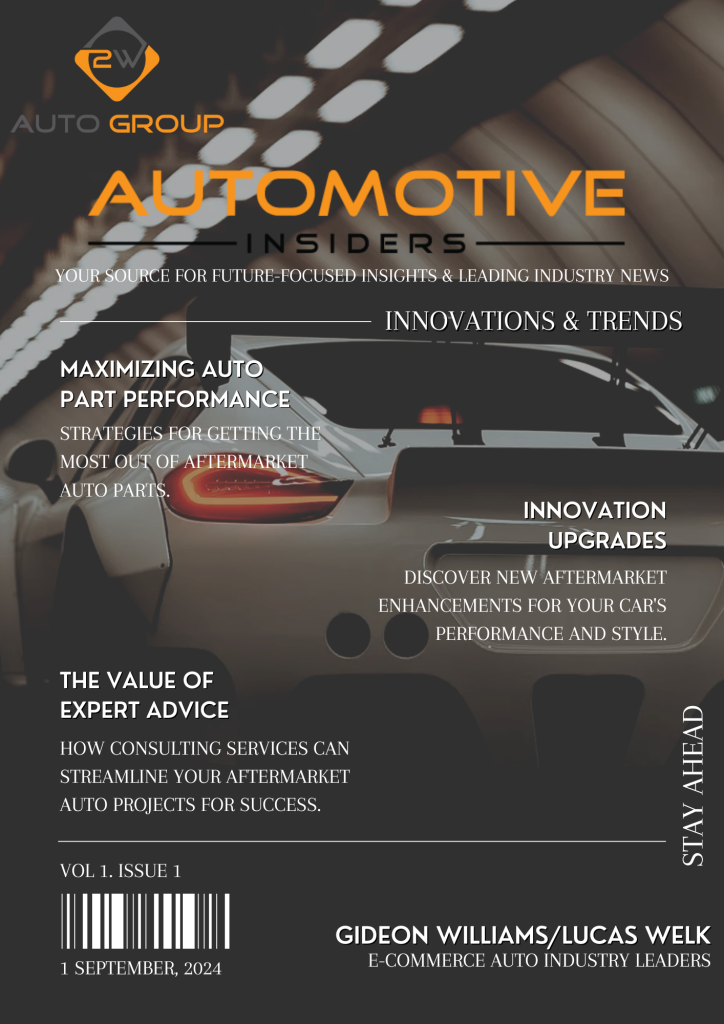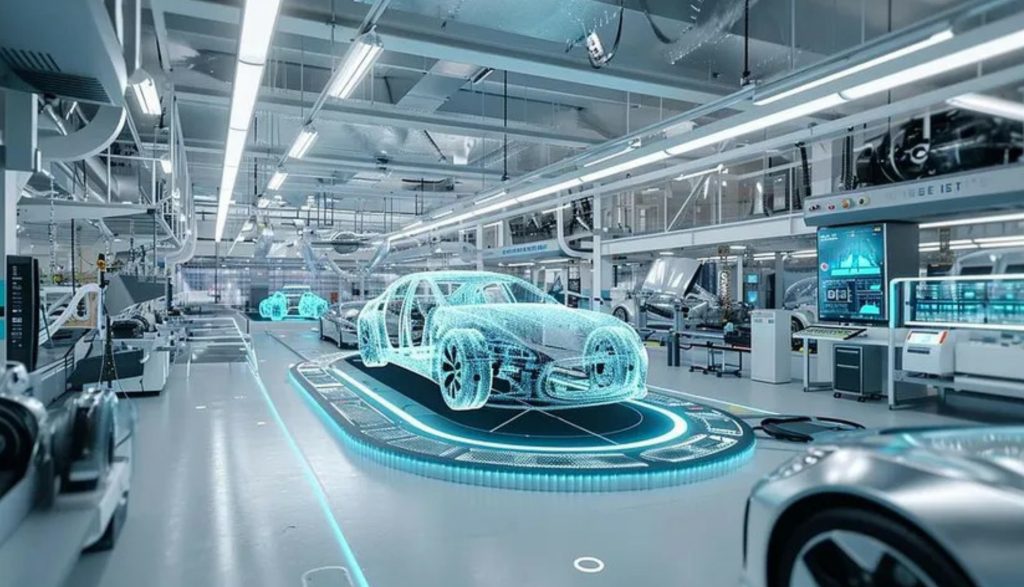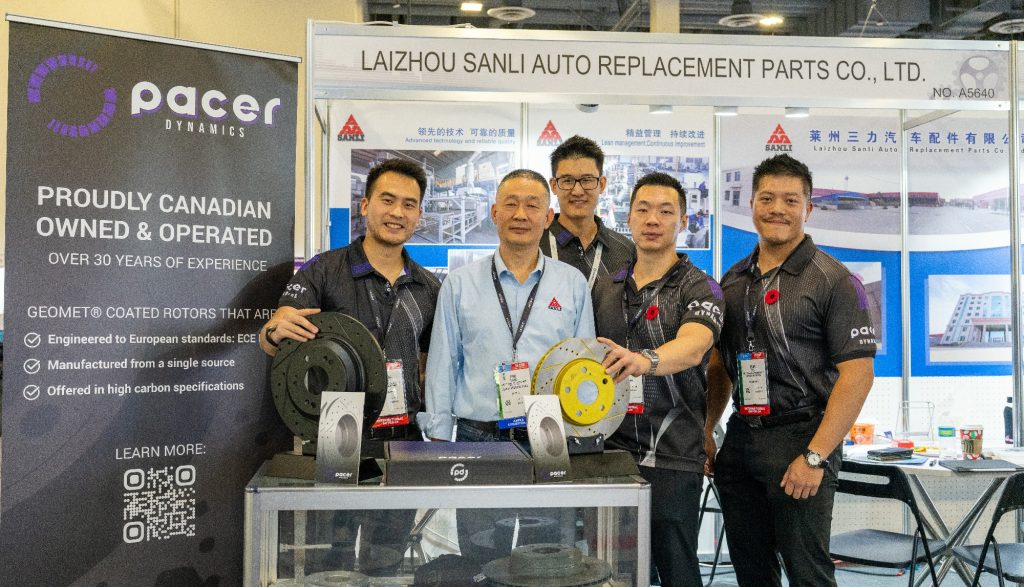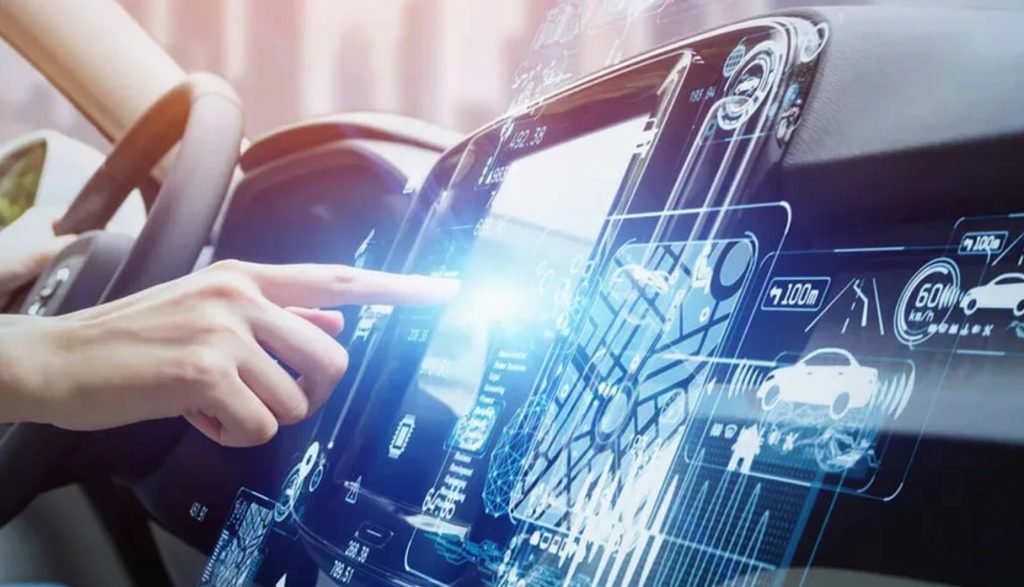Magazine Volume 1.4

-FEATURED SECTIONS- Automakers & Original Equipment Etailers & Retailers Manufacturers Technology Warehouse Distributors October 2024 -ARTICLES- Pacer Dynamics Automotive: Elevating Brake Rotor Standards Across North America From Humble Beginnings to the Big Leagues: The Story of DDR Motorsports Driving Innovation in Auto Parts Manufacturing: What’s Next? Navigating Supply Chain Disruptions: How Manufacturers Can Stay Ahead Sustainable Manufacturing in the Automotive Parts Industry: A Necessary Evolution Optimizing Warehouse Operations: The Future of Automotive Parts Distribution The Role of Automation in Modern Automotive Parts Warehouses From Warehouse to Customer: How Distributors Are Improving Last-Mile Delivery The Rise of Online Parts Retail: Navigating the Shift to E-Commerce Building the Perfect Online Shopping Experience for Auto Parts Consumers From Clicks to Cars: How Retailers Can Meet the Evolving Demands of Auto Parts Buyers The Future of OEM: How Automakers Are Adapting to the Digital Shift OEM Parts: Navigating the Balance Between Quality and Cost From Factory to Consumer: The Changing Landscape of OEM Distribution How AI is Revolutionizing the Automotive Parts Industry Blockchain: The Future of Supply Chain Transparency in Automotive Parts Tech Disruptions in Auto Parts: How IoT is Changing the Way We Do Business SUBSCRIBER EXCLUSIVE [noptin-form id=228825] LATEST ISSUES
Warehouse Distributors

Optimizing Warehouse Operations: The Future of Automotive Parts Distribution The Rise of Automation One of the key trends shaping the future of automotive parts distribution is the rise of automation. From automated guided vehicles (AGVs) to robotic pickers, warehouses are increasingly turning to technology to streamline their operations. By automating routine tasks, companies can reduce labor costs, increase efficiency, and minimize human error. This not only speeds up order fulfillment but also improves inventory accuracy, leading to higher customer satisfaction. Data-Driven Decision Making Another crucial aspect of optimizing warehouse operations is the use of data-driven decision-making. With the help of advanced analytics tools, companies can track key performance metrics, such as order processing time, inventory turnover, and picking accuracy. By analyzing this data, warehouse managers can identify bottlenecks, optimize workflows, and make informed decisions to improve overall efficiency. This focus on data allows companies to stay agile and responsive to changing market demands. Embracing Sustainable Practices As concerns about environmental sustainability continue to grow, automotive parts distributors are also focusing on reducing their carbon footprint. By optimizing warehouse layouts, implementing energy-efficient lighting, and minimizing waste, companies can not only lower their operating costs but also contribute to a greener future. Sustainable practices not only benefit the environment but also enhance brand reputation and attract eco-conscious customers. Adopting Just-In-Time Inventory Management Just-in-time (JIT) inventory management is another strategy that is gaining popularity in the automotive parts distribution sector. By stocking only the parts needed for immediate orders, companies can reduce inventory holding costs and free up valuable warehouse space. This lean approach to inventory management helps companies minimize waste, improve cash flow, and respond quickly to changing customer demands. By optimizing their inventory levels, companies can achieve higher fill rates and reduce backorders. Investing in Employee Training and Development While technology plays a key role in optimizing warehouse operations, it is essential not to overlook the human element. Investing in employee training and development is crucial to ensure that staff are equipped with the skills and knowledge needed to succeed in a rapidly evolving industry. By offering continuous training programs, companies can empower their workforce, boost morale, and foster a culture of innovation. Engaged and well-trained employees are more likely to take ownership of their work, leading to higher productivity and customer satisfaction. Enhancing Customer Experience Ultimately, the goal of optimizing warehouse operations is to enhance the overall customer experience. By leveraging technology, data, sustainability practices, lean inventory management, and employee development, companies can deliver faster, more accurate, and cost-effective service to their customers. This focus on continuous improvement not only drives operational efficiency but also strengthens customer loyalty and drives long-term success in the competitive automotive parts distribution industry.Optimizing warehouse operations is essential for companies in the automotive parts distribution sector to stay competitive and meet the evolving needs of customers. By embracing automation, data-driven decision-making, sustainability practices, JIT inventory management, employee training, and focusing on enhancing the customer experience, companies can position themselves for success in the future. By humanizing these strategies and prioritizing the well-being of both employees and customers, companies can build a strong foundation for growth and innovation in the dynamic automotive industry. The Role of Automation in Modern Automotive Parts Warehouses Increased Efficiency and Accuracy One of the key benefits of automation in automotive parts warehouses is the increased efficiency and accuracy it provides. Automated systems can quickly and accurately locate parts in the warehouse, reducing the time it takes for workers to find and retrieve them. This not only speeds up the process of fulfilling orders but also reduces the likelihood of errors, ensuring that the right parts are delivered to the right customers every time. Improved Inventory Management Automation also plays a crucial role in improving inventory management in automotive parts warehouses. Automated systems can track inventory levels in real-time, making it easier for warehouse managers to monitor stock levels and reorder parts as needed. This helps to prevent stockouts and excess inventory, leading to cost savings and improved customer satisfaction. Enhanced Safety for Workers Automation in automotive parts warehouses also contributes to enhanced safety for workers. By automating repetitive and potentially hazardous tasks, such as lifting heavy parts or operating machinery, automation reduces the risk of injuries in the warehouse. This not only creates a safer working environment for employees but also helps to reduce the number of workplace accidents and associated costs. Streamlined Order Fulfillment Another benefit of automation in modern automotive parts warehouses is streamlined order fulfillment. Automated systems can quickly process orders, pick the necessary parts from storage, and package them for shipping. This not only speeds up the order fulfillment process but also allows warehouses to handle a larger volume of orders with greater efficiency. Customer Satisfaction Automation in automotive parts warehouses ultimately leads to improved customer satisfaction. By enhancing efficiency, accuracy, and speed in fulfilling orders, automation ensures that customers receive their parts promptly and in perfect condition. This helps to build trust with customers and create a positive reputation for the warehouse, ultimately leading to repeat business and referrals. Empowering Workers with Technology While automation plays a critical role in modern automotive parts warehouses, it is important to recognize that it is not meant to replace human workers but rather to empower them with technology. By automating repetitive tasks and allowing workers to focus on more complex and value-added activities, automation humanizes the industry by helping workers to develop new skills and take on more rewarding roles within the warehouse.Automation in modern automotive parts warehouses is revolutionizing the industry by increasing efficiency, improving accuracy, enhancing safety, streamlining order fulfillment, and ultimately, improving customer satisfaction. By empowering workers with technology and allowing them to focus on higher-level tasks, automation is humanizing the industry and creating a more sustainable and efficient warehouse environment for years to come. From Warehouse to Customer: How Distributors Are Improving Last-Mile Delivery Customer-Centric Approach Distributors understand the importance of putting the customer first. They are implementing customer-centric strategies to ensure a
Technology

How AI is Revolutionizing the Automotive Parts Industry Enhancing Manufacturing Processes with AI One of the key ways AI is revolutionizing the automotive parts industry is by enhancing manufacturing processes. AI-powered robots and machines can perform tasks with a level of precision and efficiency that human workers simply cannot match. This results in faster production times, reduced labor costs, and ultimately, higher quality parts for vehicles. Optimizing Supply Chain Management through AI Another way AI is transforming the automotive parts industry is through the optimization of supply chain management. AI algorithms can analyze data on factors such as demand forecasts, production capacity, and inventory levels to help manufacturers make informed decisions about sourcing and distribution. This improves efficiency and reduces the risk of disruptions in the supply chain. Improving Customer Service with AI AI technology is also being used to revolutionize customer service in the automotive parts industry. Chatbots powered by AI can provide instant assistance and support to customers, answering questions about products, helping with troubleshooting, and even facilitating the ordering process. This not only enhances the overall customer experience but also helps companies streamline their operations. Increasing Automation in Parts Development With the help of AI, automotive parts manufacturers are able to increase automation in the development process. Designing and testing parts can be done more quickly and efficiently using AI algorithms, leading to faster innovation and improved performance. This allows companies to stay ahead of the competition and meet the evolving needs of consumers. Enhancing Predictive Maintenance Capabilities AI technology is also revolutionizing the automotive parts industry by enhancing predictive maintenance capabilities. By analyzing data from sensors and other sources, AI algorithms can predict when parts are likely to fail and alert manufacturers and consumers in advance. This proactive approach reduces downtime and maintenance costs while improving overall safety on the road. Humanizing the Future of Automotive Parts As AI continues to revolutionize the automotive parts industry, it is important to remember the human element in this transformation. While AI technology is driving efficiency and innovation, it is human workers who are ultimately responsible for leveraging this technology to its full potential. By combining the power of AI with human expertise, the future of the automotive parts industry looks bright and full of exciting possibilities.AI is revolutionizing the automotive parts industry in numerous ways, from enhancing manufacturing processes to improving customer service and increasing automation in parts development. By leveraging the power of AI technology, companies in the automotive parts industry are able to stay ahead of the competition, improve operational efficiency, and provide better products and services to customers. The future of the automotive parts industry is being humanized through the integration of AI, paving the way for continued growth and innovation in this dynamic industry. Blockchain: The Future of Supply Chain Transparency in Automotive Parts What is Blockchain? Blockchain is a decentralized, distributed ledger technology that securely records and verifies transactions across a network of computers. Each transaction is stored in a “block” that is linked to the previous block, creating a chain of information that is immutable and transparent. This means that once a transaction is recorded on the blockchain, it cannot be altered or deleted, providing a high level of security and trust. The Benefits of Blockchain in Supply Chain Management One of the key benefits of blockchain technology in supply chain management is its ability to provide a complete and transparent record of every transaction that occurs within the network. This can help automotive companies track the movement of parts from the manufacturer to the end customer, ensuring that products are genuine and have not been tampered with. In addition, blockchain can also improve efficiency by reducing paperwork, streamlining processes, and eliminating the need for intermediaries. Enhancing Supply Chain Transparency with Blockchain Blockchain technology can greatly enhance supply chain transparency in the automotive industry by providing real-time visibility into the movement of parts and products. This can help companies identify and address any potential issues or bottlenecks in the supply chain, such as delays, defects, or fraud. By utilizing blockchain, automotive companies can ensure that their products are authentic, safe, and compliant with regulations. The Role of Blockchain in Ensuring Product Authenticity Counterfeit automotive parts pose a significant threat to the safety and integrity of vehicles. Blockchain technology can help combat this issue by providing a tamper-proof record of each part’s origin, history, and authenticity. This can help automotive companies verify the legitimacy of their suppliers and prevent the distribution of counterfeit parts in the market. By leveraging blockchain, companies can build trust with their customers and uphold their reputation for quality and reliability. Overcoming Challenges and Adopting Blockchain While blockchain technology holds great promise for improving transparency in the automotive supply chain, there are still challenges that must be overcome in order to achieve widespread adoption. These include concerns about data privacy, scalability, interoperability, and regulatory compliance. However, with ongoing research, collaboration, and innovation, these challenges can be addressed, paving the way for a more secure and transparent supply chain ecosystem. The Future of Blockchain in Automotive Supply Chain Transparency As the automotive industry continues to evolve, blockchain technology will play an increasingly important role in ensuring supply chain transparency and integrity. By humanizing the technology and highlighting its benefits for consumers, manufacturers, and regulators alike, we can create a more trustworthy and sustainable supply chain that benefits everyone involved. The future of supply chain transparency in automotive parts is bright, thanks to the power of blockchain technology.Blockchain is revolutionizing the way that automotive parts are tracked, verified, and authenticated throughout the supply chain. By leveraging this technology, companies can enhance transparency, ensure product authenticity, and build trust with their customers. As we look towards the future, the potential for blockchain in supply chain management is limitless, offering a new era of accountability, security, and efficiency in the automotive industry. Tech Disruptions in Auto Parts: How IoT is Changing the Way We Do Business Enhanced Inventory Management One of the
Manufacturers

From Humble Beginnings to the Big Leagues: The Story of DDR Motorsports Humble Beginnings Breed Passion The story of DDR Motorsports begins not on the asphalt tracks of today but in the gritty world of street stocks. This is where Doug Robbie, the team’s patriarch, honed his racing skills and ignited a lifelong passion for motorsports. By the early 1990s, Doug had transitioned to the prestigious Winston Modified Tour, turning wrenches for some of the top drivers in the series until the late 2000s. These formative years laid the groundwork for the competitive spirit that continues to drive DDR Motorsports forward. A Family Affair Takes the Wheel In 2004, a new chapter unfolded. Fueled by a desire to support the racing dreams of Doug’s children, Derek and Danielle, DDR Motorsports was born. The team’s initial focus shifted to Quarter Midgets, scaled-down sprint cars perfect for youngsters. Competing across multiple classes at various tracks throughout the Northeast, Derek and Danielle showcased their talent, racking up numerous victories and milestones. By 2009, it was time for the next challenge. Embracing the Dirt: Building Versatility Seeking to broaden their horizons, DDR Motorsports ventured into the world of dirt racing at Whip City Speedway in Westfield, MA. This formative period proved invaluable, helping Derek develop the versatility and resilience required to succeed in competitive racing. After a year and a half of mastering the dirt tracks, it was time to set their sights on a new challenge. Pro Four Modified Dominance: A Foundation for Success The team’s next move was to the Pro Four Modifieds of New England, marking the beginning of a highly successful chapter. These exciting 4-cylinder open-wheel racers provided the perfect platform to hone Derek’s skills on tracks that would eventually lead him to the bigger and faster 8-cylinder classes. During this period, Derek earned Rookie of the Year honors twice (2011 – Pro4 Lites, 2014 – Full Pro4). Additionally, DDR Motorsports captured the Pro4 Lite championship in 2013 and narrowly missed the Full Pro4 title in 2015, falling just short in a tiebreaker. The knowledge and experience gained with these cars laid the foundation for the team’s transition to the high-powered Tour-type cars. Taking on the Tour-Type Modified Challenge In 2017, DDR Motorsports made a bold move, entering the prestigious Modified Racing Series and going head-to-head with renowned drivers like Teddy Christopher and Anthony Nocella. This leap into the world of Tour-type Modifieds showcased the team’s ambition and skill. Drawing upon Doug’s experience from the Winston Modified Tour, DDR Motorsports consistently placed in the top finishes during their initial seasons. As their experience grew, they ventured into open competition shows, further testing their mettle in the Monaco Tri-Track Series. Adapting and Overcoming: Embracing New Challenges The past two years have presented their share of challenges, with engine failures and unavoidable mishaps disrupting the 2023 and 2024 seasons. However, the team remained resilient. Partnering with Mike Horn in an ultra-fast and nimble NEMA Midget allowed Derek to sharpen his skills and ensure continuous growth even amidst setbacks. Through it all, DDR Motorsports never lost sight of their modified roots, ensuring every decision and plan ultimately strengthened their core program. The Power of Partnership: Fueling the Drive for Excellence The success of DDR Motorsports is deeply rooted in the unwavering support of their sponsors. From the durability ensured by New Hampshire Oil Undercoating to the skilled workforce connections provided by Skilled Trades Partners, each collaboration plays a vital role. Road Active Suspension enhances stability for the team’s hauler, while Strasburg Performance and Ashaway Performance Engines provide both reliable power and handling – crucial elements for competitive racing. Uniquely, DDR Motorsports effectively promotes these partnerships, showcasing their services across various channels. This collaborative effort fuels the team’s drive for excellence on every level. The Road Ahead: Setting a Course for the Whelen Modified Tour DDR Motorsports now sets its sights on the ultimate level of competition: the Whelen Modified Tour – NASCAR’s oldest division and the pinnacle of Tour-type modified racing. As the team has matured and honed its craft, they look to reach for the stars. Though not for the faint of heart, the team is not shy in chasing this goal. They believe a detailed plan, hard work, the correct resources, and, of course, a little luck can achieve the goal. The team also understands reaching this milestone will require increased funding and strategic partnerships. With unwavering determination and a strong brand, the team seeks to collaborate with sponsors who share their vision for success. A Legacy Built on Passion: The Journey Continues The story of DDR Motorsports is one of resilience, innovation, and an unwavering passion for racing. It is a testament to a family dedicated to achieving greatness on the track. Ready to Join the Ride? Interested in partnering with DDR Motorsports and being part of their journey to the top? Contact the team at info@ddr-motorsports.com to learn how your company can benefit from this exciting collaboration. Pacer Dynamics Automotive: Elevating Brake Rotor Standards Across North America The automotive industry is evolving rapidly, and Pacer Dynamics Automotive is rising to the challenge with precision-engineered brake solutions tailored to a wide range of vehicle segments, prioritizing passenger vehicles, medium-duty trucks, heavy-duty fleets, and performance applications. Guided by core values—delivering customer experience excellence, ensuring consistent quality, and promoting sustainability by minimizing waste throughout the value chain and the product lifecycle—Pacer Dynamics combines time-tested practices with modern technology to meet the demands of a dynamic market. At the heart of Pacer Dynamics’ offerings is its high-carbon brake rotor line, designed to meet rigorous European standards (ECE R90) for durability and performance in the aftermarket. Pacer Dynamics’ rotors are produced in a generationally owned 2.1 million sq. ft. factory with an annual production capacity of over 13 million rotors. With contributions from both its Canadian and international teams, consistent quality and reliability are ensured across all applications. “Our products are carefully designed to meet the unique demands of each application,” says Eddie
Etailers & Retailers

The Rise of Online Parts Retail: Navigating the Shift to E-Commerce Convenience at Your Fingertips One of the major benefits of online parts retail is the convenience it offers to consumers. Instead of having to visit multiple stores to find the right part, car owners can now simply browse through various online shops from the comfort of their homes. With just a few clicks, they can compare prices, read reviews, and make a purchase without ever leaving their couch. A Wide Range of Options Another advantage of shopping for auto parts online is the vast selection of products available. Whether you’re looking for OEM parts, aftermarket components, or even rare vintage pieces, you’re likely to find what you need online. This abundance of options allows consumers to find the best part for their vehicle without having to settle for whatever is in stock at their local auto parts store. Competitive Pricing Online parts retail has also led to increased competition among sellers, ultimately benefitting consumers in the form of competitive pricing. With multiple online retailers vying for business, car owners can often find better deals and discounts online than they would in traditional brick-and-mortar stores. This means that saving money on auto parts is now easier than ever. Expert Advice Despite the convenience of online shopping, many car owners may feel overwhelmed by the technical aspects of purchasing auto parts. This is where online parts retail shines, as many websites offer expert advice and resources to help consumers make informed decisions. From detailed product descriptions to how-to guides, online retailers strive to educate their customers and simplify the purchasing process. Customer Satisfaction With the rise of online parts retail, customer satisfaction has become a top priority for many sellers. Online retailers understand the importance of providing excellent customer service, including fast shipping, easy returns, and responsive support. This focus on customer satisfaction ensures that car owners have a positive shopping experience and are more likely to return for future purchases. Embracing the Future of Auto Parts Retail As the automotive industry continues to evolve, the shift to e-commerce is expected to only gain momentum. By embracing online parts retail, car owners can take advantage of the convenience, selection, and competitive pricing that it offers. With expert advice and top-notch customer service, navigating the world of online parts retail has never been easier. So, next time you need to purchase auto parts, consider going online and experiencing the future of auto parts retail for yourself. Building the Perfect Online Shopping Experience for Auto Parts Consumers The Needs of Auto Parts Consumers The first step in building the perfect online shopping experience for auto parts consumers is to understand their needs and preferences. Auto parts consumers are often looking for specific parts for their vehicles, and they want to easily navigate through products and find what they need quickly. By conducting market research and gathering feedback from customers, auto parts retailers can gain valuable insights into what their customers are looking for. Creating a User-Friendly Website One of the key factors in providing a positive online shopping experience is having a user-friendly website. Auto parts retailers should invest in a well-designed website that is easy to navigate and search for products. By organizing products into categories and providing detailed product descriptions and images, retailers can help customers make informed purchasing decisions. Personalizing the Shopping Experience Personalization is another important aspect of creating the perfect online shopping experience for auto parts consumers. By using data and analytics, retailers can recommend products that are relevant to each customer’s specific needs and preferences. For example, a customer who has purchased brake pads in the past may receive recommendations for related products, such as brake rotors or calipers. Providing Excellent Customer Service Customer service is essential in building trust and loyalty with auto parts consumers. Retailers should provide multiple channels for customers to contact them, such as phone, email, and live chat. By offering prompt and helpful assistance, retailers can address any issues or concerns that customers may have during the shopping process. Offering Fast and Reliable Shipping Another important factor in providing a positive online shopping experience is offering fast and reliable shipping options. Auto parts consumers often need their parts quickly in order to make necessary repairs to their vehicles. Retailers should offer expedited shipping options and provide tracking information so customers know when to expect their orders. Implementing a Seamless Returns Process Finally, retailers should make it easy for customers to return or exchange products if needed. By implementing a seamless returns process, retailers can instill confidence in customers and encourage them to make future purchases. Providing clear return policies and instructions can help reduce any friction in the customer’s shopping experience.Building the perfect online shopping experience for auto parts consumers requires a combination of user-friendly website design, personalized recommendations, excellent customer service, fast shipping options, and a seamless returns process. By humanizing the online shopping experience and focusing on the needs and preferences of customers, auto parts retailers can create a loyal customer base and drive sales growth. From Clicks to Cars: How Retailers Can Meet the Evolving Demands of Auto Parts Buyers The Shift to Online Shopping One of the biggest changes in the auto parts industry is the shift towards online shopping. Today, consumers can research and purchase auto parts from the comfort of their own homes, without ever having to step foot in a physical store. This trend is only expected to continue growing, making it essential for retailers to establish a strong online presence. Building Trust with Customers With online shopping comes the challenge of building trust with customers. When purchasing auto parts online, customers want to feel confident that they are getting the right parts for their vehicles. Retailers can humanize the online shopping experience by providing detailed product descriptions, offering helpful customer service, and showcasing positive reviews from satisfied customers. Enhancing the Customer Experience In addition to building trust, retailers must also focus on enhancing
Automakers & Original Equipment

The Future of OEM: How Automakers Are Adapting to the Digital Shift In today’s fast-paced and ever-changing world, the automotive industry is no exception when it comes to adapting to the digital shift. Original Equipment Manufacturers (OEMs) are continuously looking for ways to stay ahead of the curve and meet the demands of tech-savvy consumers. Let’s take a closer look at how automakers are embracing digital transformation to shape the future of mobility. The Rise of Electric Vehicles One of the most significant changes in the automotive industry is the shift towards electric vehicles (EVs). As governments around the world push for stricter emissions regulations, OEMs are investing heavily in developing and producing electric cars to meet these requirements. Companies like Tesla have paved the way for EV adoption, forcing traditional automakers to accelerate their electrification efforts. Connected Cars and IoT Another trend shaping the future of OEMs is the integration of connected car technologies and the Internet of Things (IoT). Vehicles are becoming more than just a mode of transportation – they are evolving into sophisticated mobile devices on wheels. Automakers are incorporating features like in-car infotainment systems, telematics, and advanced driver assistance systems (ADAS) to enhance the driving experience and improve safety. Autonomous Driving Autonomous driving is no longer a distant dream but a reality that OEMs are actively working towards. Companies like Waymo and Uber have already begun testing self-driving vehicles on public roads, signaling a future where human drivers may become obsolete. Automakers are investing in AI and machine learning technologies to develop fully autonomous vehicles that can navigate roads safely and efficiently. Sustainability and Green Initiatives With growing concern over climate change and environmental sustainability, OEMs are under pressure to reduce their carbon footprint. Automakers are increasingly focusing on eco-friendly practices, such as using recycled materials, implementing renewable energy sources in the production process, and promoting vehicle recycling at the end of their life cycle. Sustainability has become a key driver of innovation and competitiveness in the automotive industry. Digital Sales and Customer Experience In the era of e-commerce and online shopping, OEMs are rethinking their sales and distribution strategies to meet consumer expectations. Automakers are leveraging digital channels to reach customers directly, offering virtual showrooms, personalized online sales experiences, and contactless vehicle delivery options. The shift towards digital sales is not only more convenient for customers but also allows automakers to streamline their operations and reduce costs. Data Security and Privacy Concerns As vehicles become increasingly connected and reliant on data, cybersecurity and privacy concerns are top of mind for both OEMs and consumers. Automakers are investing in robust cybersecurity measures to protect vehicles from cyber threats and ensure the privacy of driver data. With the rise of autonomous vehicles and smart cities, the need for secure and trusted systems is more critical than ever.The future of OEMs in the automotive industry is undoubtedly digital. From electric vehicles and connected cars to autonomous driving and digital sales, automakers are at the forefront of innovation and transformation. By embracing new technologies and adapting to changing consumer preferences, OEMs are shaping a more sustainable, efficient, and connected future of mobility. The digital shift is not just a trend but a fundamental shift that is reshaping the entire automotive landscape.Meta Description: Learn how automakers are adapting to the digital shift and shaping the future of mobility with electric vehicles, connected cars, autonomous driving, and digital sales strategies. OEM Parts: Navigating the Balance Between Quality and Cost When it comes to purchasing OEM parts for your vehicle, finding the perfect balance between quality and cost can be a challenge. OEM (Original Equipment Manufacturer) parts are known for their superior quality and compatibility, but they often come at a higher price point than aftermarket parts. In this article, we will explore how to navigate this balance effectively, ensuring you get the best value for your money without compromising on the performance and longevity of your vehicle. The Importance of OEM Parts OEM parts are designed and manufactured by the same company that produced the original parts used in your vehicle. This means they are guaranteed to fit and function exactly as intended, providing optimal performance and reliability. While aftermarket parts may be cheaper, they are often made by third-party manufacturers and may not meet the same quality standards as OEM parts. Using OEM parts ensures that your vehicle maintains its integrity and performance levels, ultimately saving you money in the long run by reducing the risk of costly repairs and replacements. Researching and Comparing Prices When shopping for OEM parts, it’s essential to do your research and compare prices from different suppliers. While purchasing directly from the dealership may be convenient, you may find better deals from third-party retailers or online marketplaces. Be sure to compare prices, taking into account shipping costs and warranties, to find the best value for your budget. Additionally, consider purchasing in bulk or during sales events to further maximize your savings without sacrificing quality. Consulting with Experts and Professionals If you’re unsure about which OEM parts to purchase or where to find them, don’t hesitate to seek advice from experts and professionals in the automotive industry. Mechanics, dealerships, and online forums are great resources for recommendations and tips on finding the right parts for your vehicle. They can help you navigate the vast array of options available, providing insight into quality, compatibility, and pricing to ensure you make an informed decision that aligns with your needs and budget. Embracing DIY Solutions and Upgrades Another way to balance quality and cost when purchasing OEM parts is to consider DIY solutions and upgrades. Many basic maintenance tasks, such as changing oil, replacing filters, and installing new wiper blades, can be easily done at home with the right tools and guidance. By taking on these tasks yourself, you can save on labor costs and have greater control over the quality of the parts used in your vehicle. Additionally, consider upgrading certain components with OEM parts to